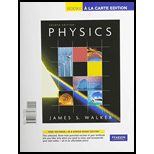
Student Solutions Manual For Masterton/hurley's Chemistry: Principles And Reactions, 8th
8th Edition
ISBN: 9781305095236
Author: Maria Cecilia D. De Mesa, Thomas D. Mcgrath
Publisher: Cengage Learning
expand_more
expand_more
format_list_bulleted
Concept explainers
Textbook Question
Chapter 20, Problem 42QAP
Rust, which you can take to be Fe(OH)3, can be dissolved by treating it with oxalic acid. An acid-base reaction occurs, and a complex ion is formed.
(a) Write a balanced equation for the reaction.
(b) What volume of 0.10 M H2C2O4 would be required to remove a rust stain weighing 1.0 g?
Expert Solution & Answer
Trending nowThis is a popular solution!

Students have asked these similar questions
Draw the most likely mechanism for the following:
Calculate the number of moles of HI that are at equilibrium with 4.9 mol of H2 and 4.9 mol of I2 in a 5.00-L flask at 448 °C. (those are the equilibrium values)
Ε.
HO
HO
Chapter 20 Solutions
Student Solutions Manual For Masterton/hurley's Chemistry: Principles And Reactions, 8th
Ch. 20 - Write a balanced equation to represent the...Ch. 20 - Write a balanced equation to represent the...Ch. 20 - Write a balanced equation to represent (a) the...Ch. 20 - Prob. 4QAPCh. 20 - Prob. 5QAPCh. 20 - Prob. 6QAPCh. 20 - Prob. 7QAPCh. 20 - Prob. 8QAPCh. 20 - Prob. 9QAPCh. 20 - Zinc is produced by electrolytic refining. The...
Ch. 20 - Prob. 11QAPCh. 20 - Prob. 12QAPCh. 20 - Prob. 13QAPCh. 20 - Prob. 14QAPCh. 20 - Prob. 15QAPCh. 20 - Prob. 16QAPCh. 20 - To inflate a life raft with hydrogen to a volume...Ch. 20 - What mass of KO2 is required to remove 90.0% of...Ch. 20 - Prob. 19QAPCh. 20 - Prob. 20QAPCh. 20 - Prob. 21QAPCh. 20 - Prob. 22QAPCh. 20 - Balance the following redox equations. (a)...Ch. 20 - Balance the following redox equations. (a)...Ch. 20 - Prob. 25QAPCh. 20 - Prob. 26QAPCh. 20 - Prob. 27QAPCh. 20 - Using Table 17.1 (Chapter 17) calculate E° for (a)...Ch. 20 - Using Table 20.4, calculate, for the...Ch. 20 - Prob. 30QAPCh. 20 - Prob. 31QAPCh. 20 - Prob. 32QAPCh. 20 - Prob. 33QAPCh. 20 - The equilibrium constant for the reaction...Ch. 20 - Using data in Appendix 1, estimate the temperature...Ch. 20 - A 0.500-g sample of zinc-copper alloy was treated...Ch. 20 - Prob. 37QAPCh. 20 - Prob. 38QAPCh. 20 - Iron(II) can be oxidized to iron(III) by...Ch. 20 - Prob. 40QAPCh. 20 - Prob. 41QAPCh. 20 - Rust, which you can take to be Fe(OH)3, can be...Ch. 20 - Prob. 43QAPCh. 20 - Prob. 44QAPCh. 20 - Prob. 45QAP
Knowledge Booster
Learn more about
Need a deep-dive on the concept behind this application? Look no further. Learn more about this topic, chemistry and related others by exploring similar questions and additional content below.Similar questions
- a. OH H₂N-O -Ph H+ acyclic productarrow_forwardeks.com/aleksogi/x/sl.exe/1o_u-IgNslkr7j8P3jH-IQs_pBanHhvTCeeBZbufuBYTI0Hz7m7D3ZS17Hd6m-HIl6n52njJN-TXdQA2X9yID-1SWQJTgnjARg30 111 States of Matter Understanding conceptual components of the enthalpy of solution 0/5 Ge A small amount of acetonitrile (CH, CN) is dissolved in a large amount of water. Imagine separating this process into the four stages sketched below. (These sketches show only a portion of the substances, so you can see the density and distribution of atoms and molecules in them.) CH,CN H₂O B 88 C Use these sketches to answer the questions in the table below. The enthalpy of solution AH is negative soln when CH3CN dissolves in water. Use this information to list the stages in order of increasing enthalpy. Would heat be absorbed or released if the system moved from Stage C to D? What force would oppose or favor the system moving from Stage C to D? Check all that apply. 1 absorbed O released neither absorbed nor released. none O ionic bonding force covalent bonding force…arrow_forwardIn a system with an anodic overpotential, the variation of ŋ as a function of the current density: 1. at low fields is linear 2. at higher fields, it follows Tafel's law Find the range of current densities for which the overpotential has the same value as when calculated for cases 1 and 2 (maximum relative difference of 5% with respect to the behavior for higher fields). To which overpotential range does this correspond? Data: 10 = 1.5 mA cm², T = 300°C, ẞ = 0.64, R = 8.314 J K 1 mol¹ and F = 96485 C mol-1.arrow_forward
- Indicate 10.6 with only one significant figure.arrow_forwardIf I have 10 data points for variables x and y, when I represent y versus x I obtain a line with the equation y = mx + b. Is the slope m equal to dy/dx?arrow_forwardThe data for the potential difference of a battery and its temperature are given in the table. Calculate the entropy change in J mol-1 K-1 (indicate the formulas used).Data: F = 96485 C mol-1arrow_forward
arrow_back_ios
SEE MORE QUESTIONS
arrow_forward_ios
Recommended textbooks for you
 Chemistry: Principles and ReactionsChemistryISBN:9781305079373Author:William L. Masterton, Cecile N. HurleyPublisher:Cengage Learning
Chemistry: Principles and ReactionsChemistryISBN:9781305079373Author:William L. Masterton, Cecile N. HurleyPublisher:Cengage Learning Chemistry & Chemical ReactivityChemistryISBN:9781337399074Author:John C. Kotz, Paul M. Treichel, John Townsend, David TreichelPublisher:Cengage Learning
Chemistry & Chemical ReactivityChemistryISBN:9781337399074Author:John C. Kotz, Paul M. Treichel, John Townsend, David TreichelPublisher:Cengage Learning Chemistry & Chemical ReactivityChemistryISBN:9781133949640Author:John C. Kotz, Paul M. Treichel, John Townsend, David TreichelPublisher:Cengage Learning
Chemistry & Chemical ReactivityChemistryISBN:9781133949640Author:John C. Kotz, Paul M. Treichel, John Townsend, David TreichelPublisher:Cengage Learning

Chemistry: Principles and Reactions
Chemistry
ISBN:9781305079373
Author:William L. Masterton, Cecile N. Hurley
Publisher:Cengage Learning

Chemistry & Chemical Reactivity
Chemistry
ISBN:9781337399074
Author:John C. Kotz, Paul M. Treichel, John Townsend, David Treichel
Publisher:Cengage Learning

Chemistry & Chemical Reactivity
Chemistry
ISBN:9781133949640
Author:John C. Kotz, Paul M. Treichel, John Townsend, David Treichel
Publisher:Cengage Learning
General Chemistry | Acids & Bases; Author: Ninja Nerd;https://www.youtube.com/watch?v=AOr_5tbgfQ0;License: Standard YouTube License, CC-BY